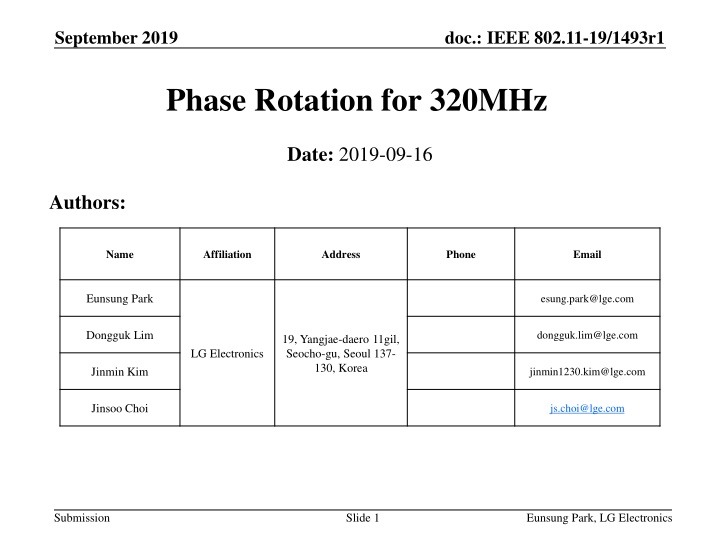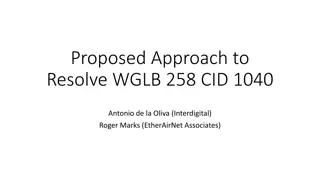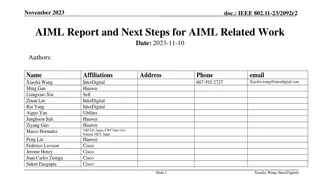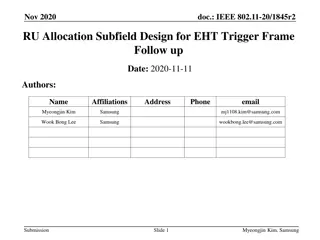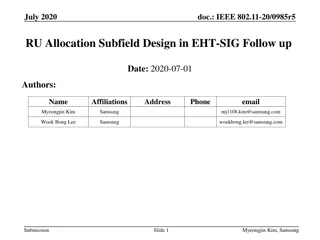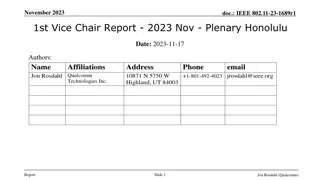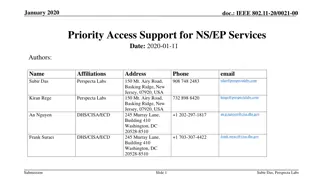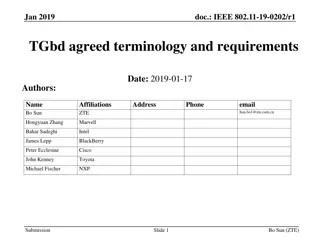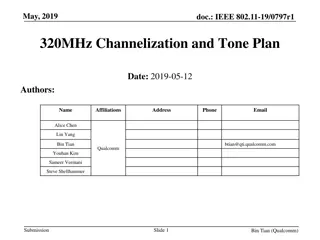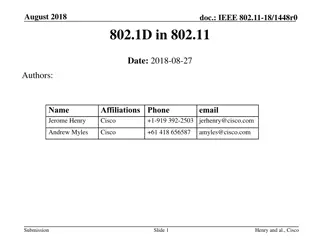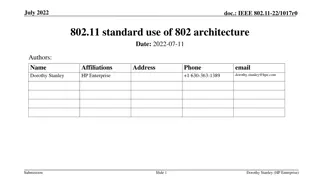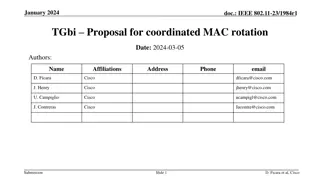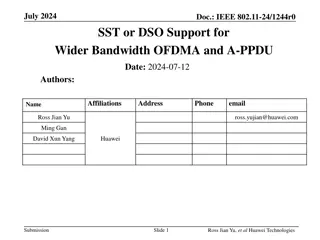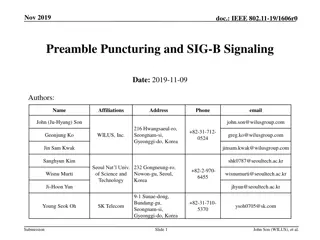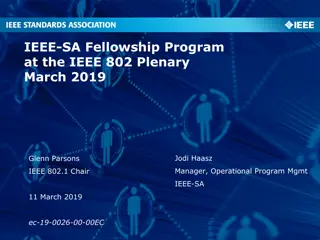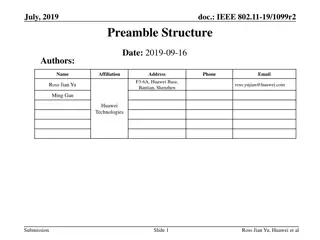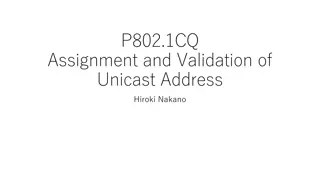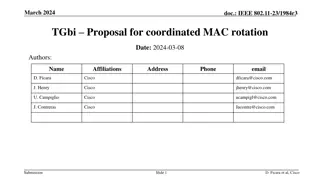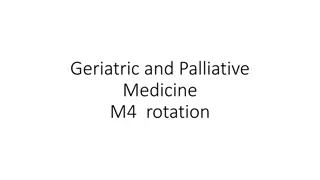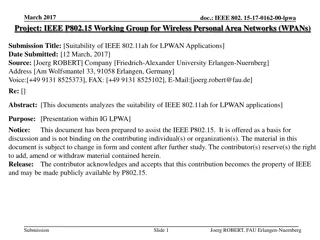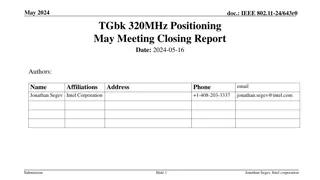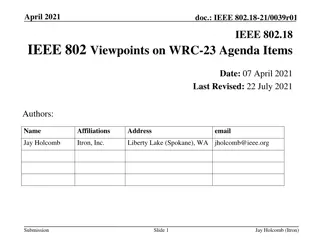IEEE 802.11-19/1493r1 Phase Rotation for 320MHz
This document discusses the design considerations for phase rotation in 320MHz PPDUs for IEEE 802.11-19/1493r1 standard, focusing on reducing PAPR and optimizing efficiency through preamble puncturing. It explores various design options and considerations, including RF capability in different bandwidth modes. The proposed phase rotation values aim to minimize PAPR across diverse scenarios and RF capabilities for enhanced performance in Wi-Fi systems.
Download Presentation

Please find below an Image/Link to download the presentation.
The content on the website is provided AS IS for your information and personal use only. It may not be sold, licensed, or shared on other websites without obtaining consent from the author.If you encounter any issues during the download, it is possible that the publisher has removed the file from their server.
You are allowed to download the files provided on this website for personal or commercial use, subject to the condition that they are used lawfully. All files are the property of their respective owners.
The content on the website is provided AS IS for your information and personal use only. It may not be sold, licensed, or shared on other websites without obtaining consent from the author.
E N D
Presentation Transcript
September 2019 doc.: IEEE 802.11-19/1493r1 Phase Rotation for 320MHz Date: 2019-09-16 Authors: Name Affiliation Address Phone Email Eunsung Park esung.park@lge.com Dongguk Lim dongguk.lim@lge.com 19, Yangjae-daero 11gil, Seocho-gu, Seoul 137- 130, Korea LG Electronics Jinmin Kim jinmin1230.kim@lge.com Jinsoo Choi js.choi@lge.com Submission Slide 1 Eunsung Park, LG Electronics
September 2019 doc.: IEEE 802.11-19/1493r1 Introduction Several contributions discussed a preamble structure for 11be and most of them considered PPDUs starting with the legacy preamble for coexistence with legacy devices [1-3] Conventional Wi-Fi systems including 11ax apply phase rotation to the legacy preamble to reduce PAPR Phase rotation can be definitely employed in 11be as well, and thus, a new design is required for 320MHz PPDUs This contribution first discusses what we need to consider to come up with the phase rotation, and then, proposes three design options Submission Slide 2 Eunsung Park, LG Electronics
September 2019 doc.: IEEE 802.11-19/1493r1 Consideration Points (1/2) Design metric Phase rotation needs to be designed to reduce PAPR PAPR for L-STF,L-LTF or L-SIG parts can be considered Preamble puncturing Preamble puncturing can be considered in 11be similar to 11ax MU PPDU to enhance the efficiency Whatever the size of the preamble puncturing unit, various puncturing patterns can be created in 320MHz PPDUs and each pattern may lead to different PAPR We need to find unified phase rotation values which minimize the worst PAPR by considering various preamble puncturing cases We can consider redesigning the phase rotation values even in 80 / 160MHz (1~2 dB lower PAPR can be achieved) Submission Slide 3 Eunsung Park, LG Electronics
September 2019 doc.: IEEE 802.11-19/1493r1 Consideration Points (2/2) RF capability regarding the bandwidth 11be may support 160+160 / 320 MHz as new bandwidth modes and PPDUs for those bandwidth can be transmitted using two RFs which can deal with up to 160MHz bandwidth or one RF which can generate 320MHz PPDU 320MHz capable RF 2x2020 11 right guard 12 left guard 5 null 5 null 23 DC 160MHz capable RF 160MHz capable RF Each part generated by different RFs may have different PAPR We need to find unified phase rotation values which minimize the worst PAPR by considering diverse RF capabilities Submission Slide 4 Eunsung Park, LG Electronics
September 2019 doc.: IEEE 802.11-19/1493r1 Design Options Option 1 Repeat 11ax / new 80MHz phase rotation [1 -1 -1 -1 1 -1 -1 -1 1 -1 -1 -1 1 -1 -1 -1] The coefficients in all 80MHz segments remain the same but it may cause somewhat high PAPR (Please see Appendix) Option 2 Repeat 11ax / new 80MHz phase rotation and apply additional phase rotation to each 80/160MHz segment [a*[1 -1 -1 -1] b*[1 -1 -1 -1] c*[1 -1 -1 -1] d*[1 -1 -1 -1]] Coefficients of a, b, c and d can be selected out of 1, -1, i and -i for simplicity Relatively low PAPR can be expected (about 1~3dB reduced) Option 3 Find optimal phase rotation for each 20MHz channel Each coefficient can be selected out of 1, -1, i and -i for simplicity Lowest PAPR can be achieved (about 3~4dB reduced) but each 80MHz segment may have totally different coefficients Submission Slide 5 Eunsung Park, LG Electronics
September 2019 doc.: IEEE 802.11-19/1493r1 Summary We have discussed the phase rotation for 320MHz in 11be Two consideration points have been presented Preamble puncturing RF capability Three design options have been presented Repeat 11ax / new phase rotation Repeat 11ax / new phase rotation and apply additional phase rotation Find optimal phase rotation Submission Slide 6 Eunsung Park, LG Electronics
September 2019 doc.: IEEE 802.11-19/1493r1 Straw Poll #1 Do you agree to add the following to the TGbe SFD? Phase rotation is applied to the legacy preamble part of EHT PPDU Coefficients applied to each 20MHz channel are TBD Application to the other fields is TBD Y/N/A: 28/5/9 Submission Slide 7 Eunsung Park, LG Electronics
September 2019 doc.: IEEE 802.11-19/1493r1 Motion #1 Move to add the following to the TGbe SFD Phase rotation is applied to the legacy preamble part of EHT PPDU Coefficients applied to each 20MHz channel are TBD Application to the other fields is TBD Y/N/A: 28/5/9 Submission Slide 8 Eunsung Park, LG Electronics
September 2019 doc.: IEEE 802.11-19/1493r1 Straw Poll #2 Do you agree to redesign phase rotation applied to the legacy preamble part of 80/160/80+80MHz EHT PPDU? Y/N/A: // Submission Slide 9 Eunsung Park, LG Electronics
September 2019 doc.: IEEE 802.11-19/1493r1 Straw Poll #3 Which option do you prefer for the phase rotation applied to the legacy preamble part of 320/160+160 MHz EHT PPDU? Option1 Repeat 11ax / new 80MHz phase rotation Option2 Repeat 11ax / new 80MHz phase rotation and apply additional phase rotation to 80/160 MHz segment Option3 Optimal phase rotation Option1/Option2/Option3/None of them/Abstain: Submission Slide 10 Eunsung Park, LG Electronics
September 2019 doc.: IEEE 802.11-19/1493r1 References [1] 802.11-19/1099r0 Preamble Structure [2] 802.11-19/1142r0 Discussion on the preamble for 11be [3] 802.11-19/1214r0 Preamble Design Consideration for 11be Submission Slide 11 Eunsung Park, LG Electronics
September 2019 doc.: IEEE 802.11-19/1493r1 Appendix PAPR when the 11ax 80MHz phase rotation is repeated 4 times IFFT is applied 80MHz: [1 -1 -1 -1] 160MHz: [1 -1 -1 -1 1 -1 -1 -1] 320MHz: [1 -1 -1 -1 1 -1 -1 -1 1 -1 -1 -1 1 -1 -1 -1] Unit: dB Full bandwidth (PAPR) Preamble puncturing (max PAPR) Bandwidth L-STF L-LTF L-STF L-LTF 80MHz 4.4380 5.3962 6.8606 7.9370 160MHz 5.9144 6.4716 9.8709 10.9473 320MHz 8.2600 9.1864 12.8812 13.9576 Submission Slide 12 Eunsung Park, LG Electronics
